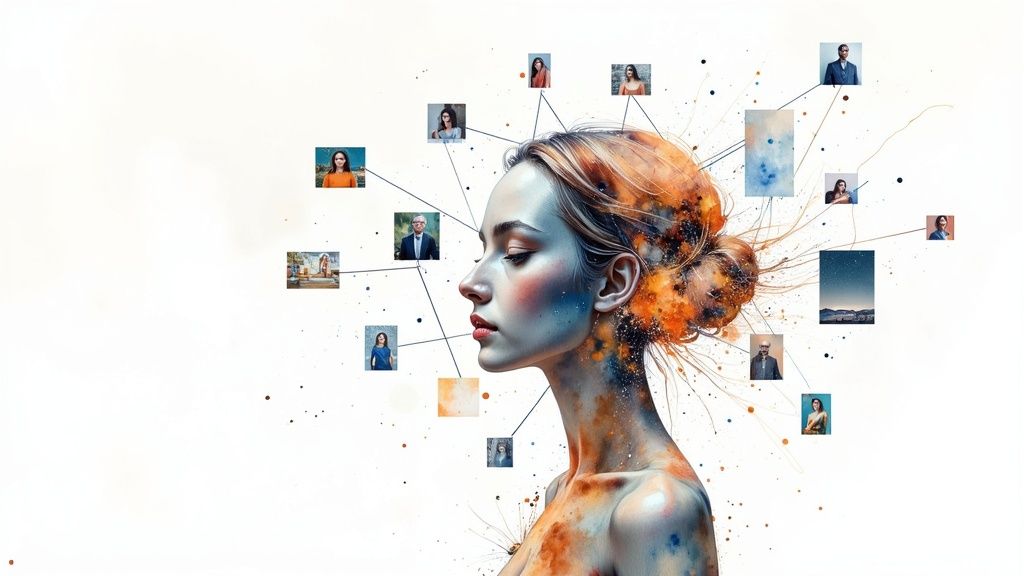Understanding the AI Revolution in Modern Advertising

Artificial intelligence (AI) is fundamentally changing how advertising works. According to recent data, 68% of marketers now use AI tools in their daily work - not because it's trendy, but because it consistently delivers better results. This widespread adoption shows that AI has moved beyond experimental phases to become an essential part of successful advertising strategies.
How AI is Transforming Advertising Campaigns
AI brings powerful new capabilities to advertising campaigns. At its core, AI helps marketers understand and reach their audiences more effectively by analyzing consumer behavior patterns across large datasets. This improved targeting means ads reach the right people at the right time. AI also helps optimize advertising budgets by identifying which campaigns are most likely to succeed, reducing wasted spending and improving return on investment. But perhaps most importantly, AI is opening up new possibilities in how ads are created.
The Power of AI in Content Creation
Creating engaging advertising content at scale is where AI truly shines. Modern AI tools can help write compelling ad copy, design visuals, and even produce video content. This frees up creative teams to focus on high-level strategy and big ideas while AI handles repetitive production tasks. The technology also enables true personalization by efficiently creating multiple versions of ads tailored to different audience segments. Of course, this raises important questions about balancing AI assistance with authentic brand voice and creative control. Learn more in our article about How AI is shaping the future of advertising.
Real-World Examples of AI in Action
The results speak for themselves when we look at real campaigns using AI. Some brands have seen their campaign performance improve by up to 250% after implementing AI solutions. This dramatic improvement comes from better targeting, personalized content that resonates with specific audiences, and smarter budget allocation. For example, AI-powered recommendation engines on Facebook have proven particularly effective at increasing user engagement with ad content, showing how AI can enhance existing advertising platforms.
Building a Successful AI Advertising Strategy
Success with AI requires thoughtful implementation. Start by identifying specific areas where AI can add the most value to your advertising efforts - whether that's audience segmentation, performance prediction, or content creation. Set clear goals and metrics to measure AI's impact. Remember that AI works best as a powerful tool that enhances human creativity and strategic thinking, not as a replacement for them. The most successful advertising strategies find ways to combine AI's analytical capabilities with human insight and creative vision.
Making Smart Investments in AI-Powered Advertising
Understanding how to invest strategically in AI advertising technology makes the difference between wasting resources and achieving meaningful results. While many marketers carefully test AI with small budget allocations under 10%, forward-thinking companies investing over 40% of their advertising spend in AI solutions are seeing strong returns. This gap shows the importance of knowing exactly where and how to direct AI investments.
Identifying High-Impact AI Solutions
Success with AI advertising requires matching specific tools to clear business goals. If you want to improve audience targeting, choose AI platforms that analyze customer behavior patterns to identify the most promising prospects. Well-targeted campaigns connect with the right audiences at optimal times, boosting engagement metrics and sales. AI can also direct ad spend to top-performing campaigns through predictive analytics, preventing waste on underperforming ads. This data-focused method helps marketing teams make informed choices about where to concentrate their AI and advertising investments.
Measuring AI Implementation Success
Getting value from AI requires tracking clear performance metrics from the start. Decide which specific numbers matter most - whether that's click-through rates, conversion percentages, or brand awareness scores. Following these key performance indicators (KPIs) shows exactly how AI impacts results. The data helps justify AI investments and shape strategy improvements. For example, seeing a 15% boost in click-through rates after implementing an AI tool directly demonstrates its value through measurable improvement.
Avoiding Common Investment Pitfalls
Don't get distracted by impressive-sounding AI tools that lack real practical value. Do thorough research to find solutions that truly fit your needs and can deliver concrete results. This careful evaluation prevents spending on tools that won't meaningfully help your business. Focus on how new AI systems will work with your current technology and processes. An AI tool working in isolation won't transform your advertising - it needs to smoothly connect with your existing workflow. Think of it like adding a powerful new feature to your tech stack - it only provides value when it works well with everything else.
Building a Sustainable AI Investment Roadmap
Long-term success requires a clear plan for growing your AI advertising capabilities over time. Start with focused pilot projects in specific areas before expanding AI use more broadly. This measured approach allows for testing and refining strategies. For instance, you might first try an AI content creation tool for one campaign type, analyze the results, and adjust based on what you learn. This step-by-step process builds understanding before wider implementation. Like architectural blueprints guide construction, a detailed AI roadmap provides direction for maximizing impact. Strategic investment choices, consistent measurement, and ongoing optimization unlock AI's full potential for driving advertising performance and sustainable growth.
How AI is Changing Content Creation

AI is fundamentally changing how marketing teams create content. The technology can now generate everything from ad copy to video scripts, helping teams produce more content faster than ever before. For instance, when launching a new product, marketers can use AI to quickly create multiple ad versions tailored to different audience segments - a task that would take days or weeks to do manually. This efficiency allows teams to test more variations and reach broader audiences.
Keeping Your Brand Voice While Using AI
As teams adopt AI tools, maintaining an authentic brand voice becomes crucial. The key is viewing AI as a helpful assistant rather than a replacement for human creativity. Like an apprentice working under a master craftsperson, AI can generate initial drafts and variations, but it needs human guidance to truly capture a brand's unique personality. Marketing teams should carefully review and refine AI-generated content to ensure it aligns with their brand values and messaging standards across all channels.
Finding Fresh Ideas Without Being Generic
AI brings exciting possibilities for creative brainstorming by analyzing content trends and patterns that can spark new campaign ideas. However, there's a real risk of producing bland, cookie-cutter content if teams rely too heavily on AI suggestions. The best approach is using AI as a collaborative tool - exploring its recommendations while applying human creativity and strategic thinking. For example, if AI spots a visual trend resonating with your target audience, your creative team can use that insight as inspiration for something truly original.
Creating Better Workflows With AI and Humans
The most effective way to use AI is building workflows that make the most of both human and machine capabilities. AI excels at repetitive tasks like creating multiple versions of ads or testing different headlines. This frees up marketers to focus on strategy, creative direction, and storytelling. AI can also help streamline content reviews - for instance, by automatically checking content against brand guidelines and flagging potential issues. This allows human reviewers to concentrate on the nuanced creative elements that require their expertise. When thoughtfully combined, AI and human creativity can produce better results than either could achieve alone.
Mastering AI-Driven Customer Engagement
The key to effective advertising today lies in going beyond simple personalization and using AI to build real connections with your audience. Smart brands focus on creating experiences that speak to people as individuals, not just data points. This approach marks an important shift in how businesses blend advertising with AI capabilities.
Building Authentic Personalized Experiences
The best AI personalization feels natural, not forced. Leading brands use AI to understand what their customers truly want and create experiences that match those preferences. Facebook provides a great example - their AI-powered recommendations led to users spending 7% more time on the platform because the content felt relevant and helpful rather than intrusive. This shows how personalization works best when it adds real value to the user experience.
Fostering Loyalty Through Intelligent Automation
AI shines at handling the many small but important tasks that build customer loyalty over time. From sending perfectly-timed offers to providing quick customer support, AI works constantly to meet customer needs. Think of it as a dedicated team member who never sleeps, freeing up your human staff to focus on complex problems and meaningful customer conversations that need a personal touch.
Creating Resonant Advertising Experiences
By analyzing customer data thoughtfully, AI helps identify which messages and creative elements connect most strongly with different audience groups. This deep understanding allows for advertising that speaks to people as individuals. For example, Pinterest's AI-powered "shop the look" feature boosted conversions by 9% because it made product discovery feel natural and helpful. This shows how AI can create advertising that people actually want to engage with. Learn more in our article about How to master buyer personas.
Examples of Successful AI-Driven Engagement
| Brand | AI Strategy | Results |
|---|---|---|
| Personalized content recommendations | 7% increase in time spent on platform | |
| "Shop the look" AI feature | 9% increase in conversions | |
| Hypothetical | AI-powered chatbot support | Improved customer satisfaction & retention |
These success stories demonstrate that effective AI advertising focuses on building genuine customer relationships. When brands use AI to understand and respond to individual preferences, they create engaging experiences that drive real results. This turns advertising from one-way broadcasting into meaningful two-way conversations between brands and customers.
Overcoming Real-World AI Implementation Challenges

While AI offers exciting possibilities for advertising, implementing it successfully requires careful planning and execution. Companies need to address both practical technical considerations and the human elements that come into play. Let's explore the key challenges and proven strategies for overcoming them.
Managing the Human Side of AI
The human impact of AI adoption is one of the biggest hurdles organizations face. Studies show that around 60% of marketing professionals worry about AI replacing their jobs. This is a valid concern that needs direct attention. Leading companies are tackling this through clear communication that emphasizes how AI supports and enhances human work rather than replacing it. For example, when teams see how AI can take over repetitive tasks like data entry and basic analysis, they can focus more on strategy and creativity. This shift not only eases fears but also gives staff opportunities to develop valuable new skills in AI management and data interpretation.
Overcoming Technical Hurdles
The technical side presents its own set of challenges. Adding AI tools to existing systems often brings up compatibility issues, requires specialized knowledge, and can strain budgets with new software and infrastructure needs. A step-by-step approach works best here. Starting small with pilot projects helps teams learn the ropes, spot potential problems early, and show concrete benefits before expanding to larger initiatives.
Building an AI-Ready Team
Getting your team ready to work effectively with AI takes focused effort and investment. This means providing training in key areas like data analysis, using AI tools effectively, and even writing AI prompts. But beyond just technical skills, success depends on creating an environment where people feel comfortable trying new things and learning continuously. When teams have room to experiment and grow professionally, they're better equipped to make the most of what AI has to offer. You might be interested in: The Top 10 AI Implementations of 2024 in Media and Marketing.
Navigating Change Resistance
People often resist new ways of working, especially when complex technology is involved. Overcoming this takes strong leadership that clearly explains the benefits of AI while creating a supportive space for learning and experimentation. Success isn't just about new tools - it's about shifting the whole organizational mindset to see AI as a valuable partner in advertising work. When companies actively address both human and technical factors, they set themselves up to get the most value from AI while keeping their teams engaged and on board with the changes.
Preparing for the Next Wave of AI Innovation

As AI technology continues to shape advertising, success requires more than just keeping up with new tools - it demands strategic preparation and foresight. By building flexible systems, developing key team capabilities, and carefully evaluating emerging trends, advertisers can position themselves to make the most of AI's advancing capabilities while maintaining effectiveness and relevance.
Building Adaptable Frameworks for Advertising and AI
AI technology evolves quickly, making flexibility essential for advertising teams. Rather than rigid approaches, focus on creating modular systems that can smoothly incorporate new AI capabilities as they emerge. This could mean designing campaigns with elements that can be adjusted easily, such as AI-generated ad copy that updates based on real-time performance data. A strong data foundation also allows teams to test and measure the impact of new AI tools effectively. This flexibility helps advertising stay responsive and results-focused as AI capabilities grow.
Developing Essential Team Skills for the Future of Advertising
One key area where teams need to build expertise is prompt engineering for AI tools. This involves learning how to give clear instructions to AI systems to get the desired content and insights. Teams need to understand how AI language models work and how to craft effective prompts that produce optimal results. Data analysis skills are also becoming crucial - marketers must know how to interpret AI-generated insights and apply them to campaign decisions. Supporting ongoing learning and skill development in these areas helps ensure long-term success with AI advertising tools.
Identifying Impactful AI Trends in Advertising
While there's constant buzz about new AI developments in advertising, not every trend deserves immediate attention and resources. The key is spotting truly significant advances that will reshape advertising practices versus temporary fads. For example, basic automation tools may offer small gains, but generative AI for content creation shows potential to fundamentally change how ads are produced. By focusing on truly impactful technologies that align with your advertising goals, you can invest resources more strategically. This requires staying informed about industry developments while carefully evaluating which innovations offer meaningful long-term value.
Actionable Roadmaps for AI Adoption
Different organizations need different approaches based on their current AI capabilities. Those starting out often see good results by focusing on foundational areas like AI-powered audience targeting or content optimization. More experienced teams can explore advanced applications like predictive analytics and personalized ad experiences. Whatever your starting point, creating clear plans with specific goals helps ensure smooth integration of AI into your advertising work.
Ready to transform your video content creation and elevate your advertising strategy with the power of AI? Explore Aeon, the innovative video creation platform designed for publishers. Aeon empowers you to effortlessly create engaging video content from text, audio, and video sources, automating your workflow and driving exceptional results. Discover the future of video creation at https://www.project-aeon.com.